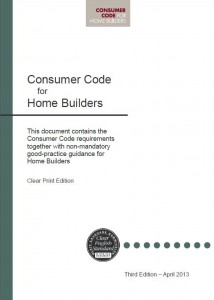The first Annual Report by the Consumer Code for Home Builders since April 2014, was finally published this month.
In May 2014, I asked the question, Is the Consumer Code for Home Builders (CCHB) fit for purpose? In March this year I wrote that the Consumer Code for Home Builders is failing new homebuyers. This voluntary code was launched in April 2010 and has been inadequate and failing new homebuyers ever since.
In July, a report published by the APPG Inquiry Into Quality of New Homes found that:
- “The Code [Consumer Code for Home Builders] does not appear to give homebuyers the safeguards we think they should expect.
- It does not appear to us objectively to offer consumers a wholly satisfactory form of redress.
- The Consumer Code for Homebuilders is limited in its scope.”
The APPG Inquiry “Key recommendation” is the setting up of a government-appointed New Homes Ombudsman. It said that the Ombudsman: “would need to be completely independent and replace the dispute resolution service offered as part of the Consumer Code for Home Builders.”
 The information contained in the Code’s belated, recently published “Annual Report 2015” covering the years 2014/15 and 2015/16, fails to justify the continued existence of this industry- led voluntary Code, in my opinion.
The information contained in the Code’s belated, recently published “Annual Report 2015” covering the years 2014/15 and 2015/16, fails to justify the continued existence of this industry- led voluntary Code, in my opinion.
The Code’s latest Annual Report claims: “the industry has made great strides in producing and updated Consumer Code which is fit for purpose in today’s world.” So by implication, the previous three editions of the Code were not fit for purpose! It remains to be seen if the latest revision, due to be implemented in April 2017, will be any better especially given the housebuilders’ continued indifference towards promoting the Code’s very existence to their customers and adhering to its Requirements. The main drivers behind this latest review would appear to be the desire for the Code to meet the Chartered Training Standards Institute’s (CTSI) Consumer Codes Approved Scheme (CCAS) accreditation requirements.
This Annual Report states that:
“In 2014, the Code’s management board took the decision to gain approval through the Chartered Trading Standards Institute (CTSI) Consumer Codes Approval Scheme (CCAS). It was important to show how the Code helps strengthen consumer protection and improve customer service standards by approval of the CTSI under their CCAS. This facilitated self-regulation.”
It will take more than the approval of the CTSI to do that! So how is this going nearly three years later?
Carol Brady, Secretariat for Consumer Code for Home Builders tells me:
“As to our application to the Chartered Trading Standards institute (CTSI) under their Consumer Codes Approval Scheme I should advise that it is not being made in order to comply with the EU Directive as you have stated, given that such a Directive does not apply to the sale of new homes. It is being made however, as cited in the report, to show how the Code helps strengthen consumer protection through that approval process. The Code is at stage 2 of the CTSI process (the period in which it demonstrates it is working well in use) and we envisage this continuing into 2017. Furthermore, it is perhaps worth noting that CEDR Ltd, who operate our Independent Dispute Resolution Scheme, are a certified ADR provider with CTSI and while we have no obligation to follow the requirements under the Directive, we may choose to do so in order to demonstrate good practice.”
However, in a letter I received on 10 March 2015, from the then Minister for Communities Stephen Williams MP, he said:
“Under the EU Directive we will need to ensure that ADR [Alternative Dispute Resolution] provided by a certified ADR body is available for any dispute concerning contractual obligations between a consumer and a business. For the Consumer Code [CCHB] to be a certified body it will need to be registered and approved with the CTSI and show that it meets the principles set out in the Directive and associated Regulations.”
It would appear the CCHB is concerned that “some warranty providers are seeking the approval of similar Codes by the CTSI. [sic]” It says these Codes may offer similar protection to consumers but “has the potential of creating some confusion for consumers.”
The Annual Report also states that the Code’s credibility was “recognised by the Help to Buy scheme, with the requirement that the terms of the Code should be observed by Home Builders promoting Help to Buy.” Given that housebuilders regularly fail to comply with even the most basic requirements, to display the Code (only around 30% comply) and give a copy of the Code to buyers (only 55% compliance), you have to ask why these housebuilders are still able to offer the Help to Buy scheme to their customers? Maybe perhaps, the confidentiality of the CCHB-AS is enabling miscreant housebuilders to get away with their non-compliance with impunity?
So what are the proposed amendments to the Code?
- “Improving consumer awareness of the Code by encouraging its greater prominence in sales offices. By making it a mandatory requirement that there is a visible display of the Code in Site Sales and Estate Agents offices at the point of sale.
- Supporting online training for front-line sales staff to improve overall compliance with the Code at the point of sale;
- Improving the pre-purchase information Home Buyers receive when making purchasing decisions such as information on event fees.”
Protecting the vulnerable
The CTSI’s CCAS requires (C5) the Code to address how Home Buyers will be treated when in their own homes require housebuilders to take into account the homebuyer’s vulnerability when dealing with them in their home, for example if the homebuyer is elderly, has a disability or English is not their first language, suggesting further assistance might be required.
“In future Code editions of the guidance provided to Home Builders, they will be reminded that their customers should not be subjected to high pressure selling techniques and the needs of vulnerable customers should be considered.”
Such high pressure selling techniques may include: encouraging a reservation by implying there are other interested parties or that there is an imminent price increase due where there is neither, offering a financial incentive for an instant decision or encouraging a reservation by refusing the opportunity to personalise the new home where the stage of construction would still allow it. So only “guidance” – should this not be mandatory?
The CTSI’s Consumer Codes Approval Scheme (CCAS) aims to promote consumer interests by setting out the principles of effective customer service and protection. It goes above and beyond obligations required by consumer law, setting higher standards and giving consumers confidence that Code members can be trusted from their right to display the CTSI “Approved Code” logo.
This Annual Code Report re affirms “the aim of the Code (new words shown in bold) to ensure that all new homebuyers:
- Are treated fairly at all times;
- Are given reliable information about their purchase and consumer rights before and after they move in to their new home;
- Know what level of service to expect;
- Know how to access an independent, speedy, low-cost dispute resolution scheme to deal with any complaints.”
Mystery shopping results indicate this is not happening
The Code uses mystery shopping to “ensure that the effectiveness of the Code is being properly tested.”
The report published results showing that:
- A third of homebuyers (33% – 32% in 2013/14) unaware of the Code, would know more after visiting a housebuilder’s site.
- Site Sales awareness of the Code was 80% (78.5% in 2013/14)
- The number of housebuilders displaying the Code is 30% (27.5% in 2013/14)
- The number of mystery shoppers given a copy of the Code on request was 21.5%, with a further 17.5% being directed to the builders’ or Code’s website. (15% and 20% respectively in 2013/14)
 However buyer’s responses to Question 19 of the HBF 8-week survey: “Were you given a copy of the Consumer Code for Home Builders?” show that despite a 19% increase in the number of completed surveys returned, there was a reduction in the number of homebuyers that received a copy down from 57% to 55%.
However buyer’s responses to Question 19 of the HBF 8-week survey: “Were you given a copy of the Consumer Code for Home Builders?” show that despite a 19% increase in the number of completed surveys returned, there was a reduction in the number of homebuyers that received a copy down from 57% to 55%.
So it is even more astounding that in the CCHB Chairman’s introductory statement he says that: “the industry has wholeheartedly embraced the Code” when the findings in his Annual Report and adjudication case summaries clearly show clear evidence the opposite is true.
The Code has been in existence for seven years, yet housebuilders are still failing to display the Code and promote it in their site sales offices. Nearly half of all new homebuyers are not given a copy of the Code – a clear breach of Code Requirement 1.2. Perhaps the Consumer Code for Home Builders should actually print 200,000 bound copies a year and distribute them to every housebuilder’s sales office rather than rely on often busy, site sales advisors printing a copy via a computer or photocopying when someone asks for a copy.
In the real world, housebuilders do not want to advertise and promote the Code’s existence as it would result in a dramatic increase the number of complaints for adjudication. Since April 2010, a total of just 193 cases have been brought by new homebuyers (to June 2016), 111 succeeding in full or in part. In 2015, the average sum awarded was £2,031. The Annual report confirms a downward trend of average awards over the last three years, £2,219 in 2014 and £2,651 in 2013. Adjudication decisions are final and not open to either review or appeal.
The most frequent breaches to Code Requirements by housebuilders are:
- Failure to have a system in place for handling and resolving complaints (Requirement 5.1) (in 54% of all successful cases in 2015)
- Failure to provide adequate pre purchase information or misleading prices (Requirements 1.5, 2.1 – in 37% of all successful cases in 2015)
- Failure to provide reliable and realistic home completion date information (Requirement 3.2 – in 35% of all successful cases in 2015)
- Pressure from house builder for buyers to agree to contractual changes (Requirement 3.1)
- Unfair and/or unclear terms in sales contracts. (Requirement 3.1 – in 24% of all successful cases in 2015)
- Misrepresentation of property description (Requirement 1.5)
- Breaching Reservation Agreements and non-repayment of reservation fees (Requirement 2.6)
So why are these housebuilders still able to offer Help to buy?
Why are these housebuilders still registered with a warranty provider?
Why are the non-compliant housebuilders not named?
It is clear to me that the language used in the latest Code Annual Report that the CCHB is running scared of a completely independent, government-appointed, and free to use New Homes Ombudsman Service that would adjudicate on everything regarding new homes, including poor quality and warranty issues. The Code has consistently failed in its attempts to raise its profile, whilst housebuilders continue to appear to breach Code Requirements with apparent impunity.






